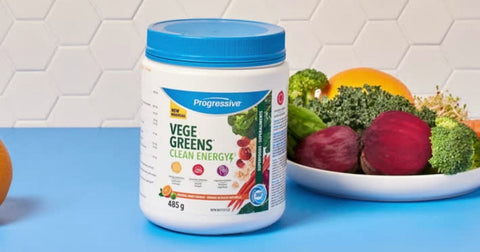Are you finding it difficult to decide what supplements you should be taking? Trust us, we get it. Learning about how to optimize your wellness, to take your health to the next level, can be intimidating. Luckily, you don’t have to do too much thinking.
Here are the top 4 products that are most added to carts.
Everyone needs a multivitamin. It’s your one-stop shop for all your vitamins and minerals. Now there is no discounting the importance of meeting your daily vitamin needs through diet, but there is also no discounting how difficult it can be to eat 6-8 servings of fruits and vegetables, as per Health Canada’s Food Guide recommendation, every single day. That’s probably why people are adding our multivitamins to their cart - because it’s a great insurance policy.
When it comes to shopping for a multivitamin, there are a few things to keep in mind. Age, sex, activity level, and life stage influence how many nutrients your body needs. Older adults require more nutrients, especially vitamin D, magnesium, and catenoids, to maintain muscle strength.1 There are sex-specific differences as well. For instance, folic acid, calcium, vitamin D, and iron are important vitamins that women should strive to get enough of.2 Those that are very active require more B vitamins and antioxidants to compensate for the losses and combat the oxidative stress created during exercise.
Progressive Multivitamins are most added to carts because our multivitamins are more than just your average multi. They also offer green food concentrates, phytonutrients, antioxidants, herbal extracts and botanicals for additional support. Find the multivitamins that are best suited for you and level up your health today.
When your parents told you to eat your greens, they had a point! Vegetables, with their array of colours, provide potent antioxidants which are essential for good health. Antioxidants stabilize free radicals - unstable cells that have a tendency to wreak havoc on our body in their search to become balanced.
Even Health Canada recommends filling half a plate with fruits and vegetables, but only one in five Canadians eats a dark green vegetable daily, while only one in ten eats an fruit or vegetable daily.3,4 This is why VegeGreens is an important addition. It can help meet your antioxidant needs and it offers foods, like kelp, which aren’t a staple food. You can enjoy VegeGreens simply in your water or try VegeGreens green smoothies!
You are not what you eat; you are what you absorb.5 The digestive system plays an important role in absorbing and utilizing the key nutrients from food and supplements. That’s why it’s important to think of gut health when starting a supplement routine. Supporting digestion is also important as sub-optimal gut health can lead to low energy, low mood, achy joints and body pain.6-8
Probiotics are beneficial bacteria that promote favourable gut flora9 and contribute to a healthy digestive system that can optimally absorb and synthesize nutrients.10 Probiotics give you more than just better digestion. Research shows that certain probiotic strains may support many important functions within the body, like inflammation11, immunity12 and mood.13 When considering taking a probiotic, it’s also important to think about prebiotics – fuel for good bacteria in the gut.14 Perfect Probiotic 60 billion is the perfect blend of probiotics and prebiotics, contributing to a healthy and nourished microbiome. Thanks to special capsule technology, Perfect Probiotics bypass the acidic environment of the stomach, ensuring all healthy bacteria are delivered, alive, to the intestinal tract. Start supporting your gut with a probiotic today!
Protein is an important macro-nutrient that is essential for every diet. Protein is the major structural component of all cells in the body. The recommended daily allowance (RDA), set by Health Canada, recommends that most adults have 0.8 grams of protein per kilogram of body weight per day.15 And if you are very active, you need about 1.2 – 2 g/kg.15 Research shows that protein is important for muscle growth and repair,16 controlling hunger levels,16 positively impacts bone health, 17 and plays an important role in neurotransmitter production which contributes to mood. 18
Our Grass-fed Whey Protein Isolate is most added to carts because it makes it easy to achieve your protein goals. It’s an ultra-clean protein featuring 100% New Zealand whey. What’s the difference between whey and whey isolate? Whey isolate is a filtered version of whey that removes fat while maintaining a high-level protein intake. That’s why each scoop provides 33 grams of protein with only 0.5 g of fat, along with no sugar, artificial flavours, or sweeteners. Try adding our whey protein isolate to your favourite smoothies.
References:
- Inzitari, M., Doets, E., Bartali, B., Benetou, V., Bari, M., Visser, M., … Salva, A. (2011). Nutrition in the age-related disablement process. The Journal of Nutrition, Health & Aging, 15(8), 599–604.
- Hatton, P. H. (2021, March 16). Women's nutrition needs. Health Canada . Retrieved March 10, 2023, from https://www.canada.ca/en/department-national-defence/maple-leaf/defence/2021/03/women-nutrition-needs.html
- Health Fact Sheets. Fruit and vegetable consumption, 2017. https://www150.statcan.gc.ca/n1/pub/82-625-x/2019001/article/00004-eng.htm
- Black, J. (2013). Do Canadians meet Canada’s Food Guide’s recommendations for fruits and vegetables? Applied Physiology, Nutrition, and Metabolism, 2013, 38(3): 234-242, https://doi-org.proxy.library.brocku.ca/10.1139/apnm-2012-0166
- Chapman, J., Nguyen, Q., & Deane, M. (2013). Gastrointestinal dysmotility: evidence and clinical management. Current Opinion in Clinical Nutrition and Metabolic Care, 16(2), 209–216. https://doi.org/10.1097/MCO.0b013e32835c1fa5
- Brown, K., DeCoffe, D., Molcan, E., & Gibson, D. L. (2012). Diet-induced dysbiosis of the intestinal microbiota and the effects on immunity and disease. Nutrients, 4(8), 1095–1119. https://doi.org/10.3390/nu4081095
- Jarrett, M.E. et al. (2016) Relationships of abdominal pain, reports to visceral and temperature pain sensitivity, conditioned pain modulation and heart rate variability in irritable bowel syndrome. NeurogastroenterolMotil doi: 10.1111/nmo.12812.
- Irwin M. Suzanne R. Rosenthal IBD Resource Center, ARTHRITIS AND JOINT PAIN, Chronsand Colitis Foundation. https://www.crohnscolitisfoundation.org/sites/default/files/legacy/assets/pdfs/emr/arthritiscomplications.pdf
- Round, J. L., Mazmanian, S. K. (2009) The gut microbiome shapes intestinal immune response during health and disease. Nature reviews Immunology.9(5): 313-323.
- Lazar, V., Ditu, L. M., Pircalabioru, G. G., Gheorghe, I., Curutiu, C., Holban, A. M., … Chifiriuc, M. C. (2018). Aspects of Gut Microbiota and Immune System Interactions in Infectious Diseases, Immunopathology, and Cancer. Frontiers in immunology, 9, 1830. doi:10.3389/fimmu.2018.01830
- Bernini, L. J., Simão, A. N. C., de Souza, C. H. B., Alfieri, D. F., Segura, L. G., Costa, G. N., & Dichi, I. (2018). Effect of Bifidobacterium lactis HN019 on inflammatory markers and oxidative stress in subjects with and without the metabolic syndrome. British Journal of Nutrition, 120(6), 645–652.
- Girolamo, F., Coppola, C., & Ribatti, D. (2017). Immunoregulatory effect of mast cells influenced by microbes in neurodegenerative diseases. Brain, Behavior, and Immunity, 65(Complete), 68-89. doi:10.1016/j.bbi.2017.06.017
- Park, C., Brietzke, E., Rosenblat, J. D., Musial, N., Zuckerman, H., Ragguett, R., . . . McIntyre, R. S. (2018). Probiotics for the treatment of depressive symptoms: An anti-inflammatory mechanism? Brain, Behavior, and Immunity, 73(Complete), 115-124. doi:10.1016/j.bbi.2018.07.006
- Rajendran, C.K., S. Okolie, S.R., Udenigwe, C. C., & Mason, B. (2017). Structural features underlying prebiotic activity of conventional and potential prebiotic oligosaccharides in food and health. Journal of Food Biochemistry, 41(5), 1-19.
- Health Canada. (Nov 2010) Dietary Reference Intakes Reference Values for Macronutrients. Retrieved on Feb 15, 2018 from: https://www.canada.ca/content/dam/hc-sc/migration/hc-sc/fn-an/alt_formats/hpfb-dgpsa/pdf/nutrition/dri_tables-eng.pdf
- PasiaskosSM, Lieberman, HR, Fulgoni, VL. (2015). Higher-protein diets are associated with higher HDL cholesterol and lower BMI and waist circumference in US adults. The Journal of Nutrition. Mar;145(3):605-14.
- Kerstetter, J. E., Kenny, A. M., & Insogna, K. L. (2011). Dietary protein and skeletal health: a review of recent human research. Current opinion in lipidology, 22(1), 16–20. https://doi.org/10.1097/MOL.0b013e3283419441
- Rao, T. S., Asha, M. R., Ramesh, B. N., & Rao, K. S. (2008). Understanding nutrition, depression and mental illnesses. Indian journal of psychiatry, 50(2), 77–82. https://doi.org/10.4103/0019-5545.42391




